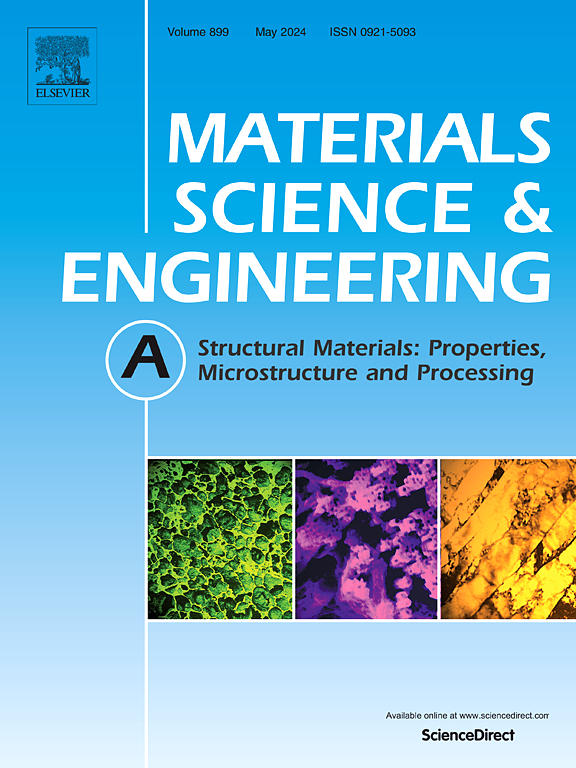增材制造Ti6Al4V合金的机热耦合疲劳行为及失效机理
IF 6.1
2区 材料科学
Q1 MATERIALS SCIENCE, MULTIDISCIPLINARY
引用次数: 0
摘要
尽管Ti6Al4V在航空航天应用中被广泛采用,但由于其在高温(高达600°C)下的平衡性能以及成本效益,我们对其在实际操作条件下(特别是在高温机械-热耦合环境下)的疲劳行为的理解仍然有限。例如,涡轮风扇叶片同时承受来自气动和燃烧环境的离心拉伸载荷和热诱导弯曲应力,而在拉伸弯曲载荷和热耦合作用下导致疲劳失效的精确变形机制尚不完全清楚,这限制了可靠性和疲劳性能的进一步提高。在本研究中,采用激光粉末床熔合(L-PBF)技术在不同的扫描速度下制备Ti6Al4V样品,在室温至600℃的温度范围内进行拉伸-弯曲复合载荷下的机械-热耦合疲劳试验。实验结果表明,随着温度的升高,疲劳寿命呈指数下降。断口形貌分析表明,高温促进了显著的塑性变形和次生微裂纹的形成,两者都加速了疲劳破坏过程。电子背散射衍射(EBSD)显微组织分析显示,晶粒尺寸减小,晶粒取向发生变化,表明塑性变形机制发生了转变。这些发现突出了位错迁移率和晶粒细化在高温下加速裂纹扩展和缩短疲劳寿命中的作用。本文章由计算机程序翻译,如有差异,请以英文原文为准。

Mechanical‒Thermal coupled fatigue behavior and failure mechanisms of additively manufactured Ti6Al4V alloy
Despite the widespread adoption of Ti6Al4V in aerospace applications, driven by its balanced performance at elevated temperatures (up to 600 °C) combined with cost-effectiveness, our understanding of its fatigue behavior under real-world operating conditions-particularly in elevated-temperature mechanical-thermal coupling environments—remains limited. For example, turbofan blades experience concurrent centrifugal tensile loads and thermally-induced bending stresses from aerodynamic and combustion environments, and the precise deformation mechanisms causing fatigue failure under tensile-bending loads and thermal coupling are not fully understood, which limits further improvements in reliability and fatigue performance. In this study, Ti6Al4V samples were fabricated via the laser powder bed fusion (L‒PBF) technique at different scanning speeds for mechanical‒thermal coupling fatigue tests under combined tensile‒flexural loading in the temperature range from room temperature to 600 °C. The experimental results reveal an exponential decrease in the fatigue life as the temperature increases. Fracture morphology analysis indicates that higher temperatures promote significant plastic deformation and the formation of secondary microcracks, both of which accelerate the fatigue failure process. Microstructural examination using electron backscatter diffraction (EBSD) revealed a decrease in grain size and a change in the grain orientation, suggesting a shift in the plastic deformation mechanism. These findings highlight the role of dislocation mobility and grain refinement in accelerating crack propagation and shortening the fatigue life at elevated temperatures.
求助全文
通过发布文献求助,成功后即可免费获取论文全文。
去求助
来源期刊

Materials Science and Engineering: A
工程技术-材料科学:综合
CiteScore
11.50
自引率
15.60%
发文量
1811
审稿时长
31 days
期刊介绍:
Materials Science and Engineering A provides an international medium for the publication of theoretical and experimental studies related to the load-bearing capacity of materials as influenced by their basic properties, processing history, microstructure and operating environment. Appropriate submissions to Materials Science and Engineering A should include scientific and/or engineering factors which affect the microstructure - strength relationships of materials and report the changes to mechanical behavior.
 求助内容:
求助内容: 应助结果提醒方式:
应助结果提醒方式:


